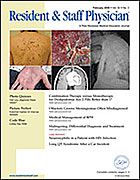Commentary
Marcia Mitre, MD, Attending Physician, Gastrointestinal Division, Department of Medicine, Allegheny General Hospital, Pittsburgh, Pa; Kyong-Mi Chang, MD, Assistant Professor, Gastrointestinal Division, Department of Medicine, University of Pennsylvania, Philadelphia, Pa
E granulosus
E multilocularis
Crandall and Madura present an interesting case of a Mexican woman with a hepatic cyst caused by a parasite that is not often seen in the United States. Human echinococcosis is caused by accidental ingestion of the tapeworm or eggs that hatch and migrate to visceral organs, most frequently to the liver. Echinococcal disease is seen worldwide but is uncommon in the United States, where it is identified mostly in immigrants from endemic countries. Diagnosis requires a high index of suspicion based on epidemiologic information and clinical findings and is confirmed by radiographic detection and serology. Clinical presentation is often nonspecific, depending on the location and size of the cyst, but can include right upper-quadrant discomfort with hepatomegaly as well as cholestatic jaundice, cholangitis, portal hypertension, and even Budd-Chiari syndrome. Rarely, patients present with peritonitis or an anaphylactic reaction caused by the ruptured cyst.
E granulosus
E
multilocularis
Cysts larger than 10 cm in diameter are more symptomatic than smaller ones. causes less symptomatic disease than . Characteristic radiographic findings include cysts in the right lobe of the liver, with internal septation as a result of daughter cysts; floating "hydatid sand" seen on ultrasound (90%-95% sensitivity); as well as calcified ring-enhancing cysts revealed on a CT scan (95%-100% sensitivity). Magnetic resonance imaging is generally not necessary, except in complicated cases.
granulosus
E multilocularis.
Serologic tests (most often indirect hemagglutination and ELISA) provide further confirmation. However, as in the case presented here, normal echinococcal antibody titer does not exclude the diagnosis, perhaps because of a weak immune response that results in false-negative results. Positive serology may be found in up to 80% to 94% of patients with conventional tests. An indirect immunofluorescence assay shows good sensitivity, with a positive response in 95% of patients with hepatic hydatid cysts.1 Serologic testing may differentiate between antigenic components of E and Microscopy of the cyst contents may demonstrate the presence of the parasite, but it did not in this report. More specific molecular methods (ie, polymerase chain reaction, Southern blot) can further enhance diagnosis.
E granulosus
E multilocularis
E granulosus
E multilocularis
Direct surgical removal is the treatment of choice in most patients. Adjunctive mebendazole or albendazole chemotherapy is recommended to reduce the risk of secondary hydatidosis caused by spillage of cystic contents (before and after surgery for and after surgery for ). Duration of chemotherapy varies from 1 month with albendazole and 3 months with mebendazole for to a minimum of 2 years of albendazole therapy for . Another approach gaining popularity is the PAIR procedure (Percutaneous Aspiration, Injection of scolicidal agent, and Reaspiration). Scolicidal agents (eg, hypertonic saline or ethanol) are injected with ultrasound guidance, and albendazole or mebendazole is administered before and after the procedure.2-4 Patients not suitable for surgical or percutaneous therapy may be managed with chemotherapy alone (albendazole or mebendazole). Treated patients may be monitored by radiographic studies (eg, ultrasound) and serology, as well as other relevant clinical parameters (eg, liver function tests). As the authors note, it is important for physicians to be familiar with diagnostic findings and treatment options for hepatic hydatid cyst.
World J
Surg.
1. Biava MF, Dao A, Fortier B. Laboratory diagnosis of cystic hydatid disease. 2001;25:10-14.
Radiology
2. Acunas B, Rozanes I, Celik L, et al. Purely cystic hydatid disease of the liver: treatment with percutaneous aspiration and injection of hypertonic saline. . 1992;182:541-543.
AJR Am J
Roentgenol
3. Men S, Hekimoglu B, Yucesoy C, et al. Percutaneous treatment of hepatic hydatid cysts: an alternative to surgery. . 1999;172:83-89.
AJR Am J
Roentgenol
4. Ustunsoz B, Akhan O, Kamiloglu MA, et al. Percutaneous treatment of hydatid cysts of the liver: long-term results. . 1999;172:91-96.
